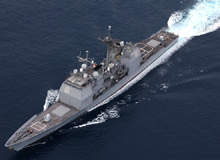
Stretching resources becomes a problem for every organisation sooner or later. Unfortunately for the US Navy, missions are not only expanding but the ability to actually execute them is becoming more difficult.
Navies have two traditional missions: sea control and power projection. To accomplish the latter, the Obama administration in the US favours the use of floating forward bases for reasons of cost and responsiveness. As all economists know, however, there is no free lunch and cutting costs could soon leave the navy reeling.
Control and denial
Sea control is a maritime nation’s primary objective in that it enables, or at least facilitates, the accomplishment of all other maritime objectives. If sea control is not possible, a nation has a fallback objective – sea denial, which is the ability to prevent others from obtaining sea control.
Sea control and denial are inverses but they are not symmetrical. Sea control is analogous to a chain where breaking one link effectively disrupts the whole system.
Sea denial is less ambitious and therefore a more achievable task. Sea control has historically required a dominant navy with global reach, whereas sea denial has not.
Today’s technological meta-trends favour sea denial over sea control. Naval forces used to have mobility and initiative advantages over land-based forces because they were at less visible and more mobile. But several technologies, such as space surveillance, have eliminated this asymmetric advantage, making intrinsic land-force advantages of terrain cover and less lumpiness (more unit divisibility) more important.
In the long term, increases in weapon range and accuracy favour the side that can deflect or absorb more punishment. All other things being equal, land-based forces have the advantage over their naval equivalents. After all, islands such as Guadalcanal in the Soloman Islands became known as “unsinkable aircraft carriers” for a reason.
(Fire) power and (force) projection
Beyond bombarding land from the sea, force projection means inserting ground forces from naval assets on to hostile territory. If ship-to-shore shellacking is sea denial extended to land, then to complete the metaphor amphibious landings are sea control extended to land.
At the land-sea boundary itself, firepower advancements cut both ways. Beaches and coastlines are inherently open and exposed areas, which means they are virtually indefensible against naval firepower, whether it is sea-launched or airborne. On the other hand, factors favouring sea denial ought to be especially significant in the case of amphibious operations, if only because naval forces have to come to land rather than the other way around.
Alternative hull and propulsion technologies such as hovercraft have given marine units more tactical mobility and enable amphibious mother ships to stay over the horizon. But increasing firepower range should be able to happen more readily than effective amphibious ferry range.
Even if landing range is increased this shifts rather than reduces the risk, as moving amphibious ships further offshore decreases their exposure but increases landing craft exposure.
In this respect, President Obama’s endorsement of the Maritime Pre-Positioning Force Squadrons (MPPFS) was unique as every other ship on the US Navy wish list has drawn some criticism from the administration. Even if World War II-style hostile beach insertions are passé, using what are essentially huge ‘roll-on roll-off’ freighters to locate materiel closer to potential hotspots is trade-off with some risk.
The obvious benefit with stationing personnel near a base is faster reaction time, as maritime assets will not have to haul heavy equipment all the way from the strategic rear. The related benefit is economic, in that keeping personnel at home and surging them forward only for imminent action is cheaper than permanent forward basing.
The danger, of course, is that the MPPFS vessels themselves will be closer to and maybe within range of an adversary’s long-range firepower. Such exposure does not automatically imply vulnerability but it does mean extra spending on protecting floating forward bases.
Defence mechanisms
With respect to survivability, the 32 ships that will comprise the MPPFS have two salient characteristics. Firstly, they have commercial designs and mostly civilian crews. Secondly, more significantly, they are unarmed. In a world of increasing oceanic visibility and shrinking sanctuaries, these ships (some of which are over three times the displacement of the new LSD-41 Whidbey Island amphibious transport class) are high-value, highly vulnerable targets.
The US Navy and its partners can in principle provide external security either by keeping these ships at dedicated forward naval bases with theatre air defence systems or by assigning escorts to them. In practice, the Military Sealift Command usually keeps these ships moving and usually individually, to prevent a single attack from wiping out large chunks of resources.
Whether these ships have escorts while underway is not readily ascertainable but considering that the US Navy has fewer Aegis cruisers than MPP ships, the latter probably have to be left unescorted for significant periods of time.
Ship and battlegroup defence against missiles is a separate matter and one that is becoming both more complex and more feasible with advances in radar, networking, lasers and design modularity. However, one thing is clear: any defence is better than no defence at all.







